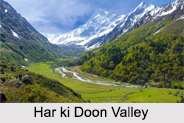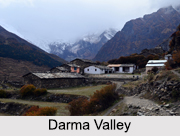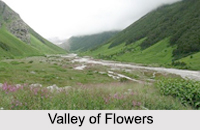 Small valleys and perennial rivers of Uttarakhand offer wonderful experience to nature lovers and hikers. The vast open hay field, above the tree line present endless views of the variously coloured Himalayan flowers. The most interesting of them, aesthetically or botanically are seen in the higher altitudes, from 2,450 metres and above. The arrival of spring brings forward an uprising of colours, when flowers like the Semal and Palash put the lower altitude forests on fire with their blazing red flowers. It is also the time for Burans to spread its fire at a height of or above 2,450 metres adding colour to the blue and white panorama of snow. The flowers do not grow only in the Valley of Flowers but are found on different treks habitually up to great heights as also on the hay field and even in rock cracks or moraines. Some of the most interesting and floristically rich natural valleys of Uttarakhand are:
Small valleys and perennial rivers of Uttarakhand offer wonderful experience to nature lovers and hikers. The vast open hay field, above the tree line present endless views of the variously coloured Himalayan flowers. The most interesting of them, aesthetically or botanically are seen in the higher altitudes, from 2,450 metres and above. The arrival of spring brings forward an uprising of colours, when flowers like the Semal and Palash put the lower altitude forests on fire with their blazing red flowers. It is also the time for Burans to spread its fire at a height of or above 2,450 metres adding colour to the blue and white panorama of snow. The flowers do not grow only in the Valley of Flowers but are found on different treks habitually up to great heights as also on the hay field and even in rock cracks or moraines. Some of the most interesting and floristically rich natural valleys of Uttarakhand are:
Har ki Doon Valley: Situated deep inside the Govind Pashu National Park, the Har ki Doon Valley is one of the most beautiful valleys in the Western Himalayas. It is nestled in the middle of a cradle-shaped vale below the Har Ki Dun peak. Known for its rich variety of flora and fauna, the trail through alpine meadows, moraine ridges, glacier basins, pine forests and ancient villages, gives the travellers and hikers a spectacular view of the valley. The Har ki Doon Valley is situated in the lying strip of Rawain sub-division of the Uttarkashi district. It is a unique valley expanding about 7 to 8 km at an altitude of 3,566 m. To reach Har-ki-Doon from Uttarkashi one passes through the Barkot Purola, Netwar and Taluka villages.
Kuthi Valley: The picturesque locations of the Kuthi valley are a delight for the mountaineers, trekkers, adventure seekers, botanists, sightseers, tourists and pilgrims. The Pithoragarh district which houses the Kuthi valley is one of the prominent halt for the people proceeding to the famous Kailash Mansarovar Yatra route. The rivers in the Kuthi valley provide excellent scope for organizing water sports, rafting etc. The region surrounding the Kuthi valley and the district of Pithoragarh are called as `Miniature Kashmir`. The valley lies in the eastern part of Uttarakhand and is joined to the Darma Valley via the Sinla and Nama pass. The highest mountain peak occupying this valley is Baba Kailash, with a height of 6,191 m. The Kuthi Valley is inhabited by the Bhotiya tribes who are found in many of the High Himalayan valleys.
 Darma Valley: The undulating picturesque landscape of the Darma Valley is interspersed with verdant forests, captivating waterfalls and streams, along with magnificent alpine meadows which host colourful wild flowers. The valley is formed by the Darma River also known as the Dhauli Ganga which meanders through the valley. The trekking trail passes through spellbinding vistas, seasonal glaciers, coniferous forests, broad fields, picturesque hamlets, and more.
Darma Valley: The undulating picturesque landscape of the Darma Valley is interspersed with verdant forests, captivating waterfalls and streams, along with magnificent alpine meadows which host colourful wild flowers. The valley is formed by the Darma River also known as the Dhauli Ganga which meanders through the valley. The trekking trail passes through spellbinding vistas, seasonal glaciers, coniferous forests, broad fields, picturesque hamlets, and more.
Saur Valley: A small valley in the Pithoragarh district, the Saur Valley stretches for about 8 km and is about 5 km wide. It is surrounded by beautiful mountains, slopes gently to the south-east, and is bisected into north and south by a tubular ridge of slate, limestone and greenstone originating in the mountains to the north-west and branching down to the south-east. Nestled at an altitude of 1,650 m, the valley offers panoramic views of the vast snow range extending across Trishuli, Nanda Devi, Panchchuli Group, and Adi of Nepal from a place named Chandak.
Johar Valley: Also known as the Milam or Gori Ganga Valley, the Johar Valley is located along the Gori Ganga River. The valley offers excellent trekking and climbing opportunities. The abandoned ghost villages, fabulous terrain, views of the great Nanda Devi and the Milam glacier beckon the trekker into a journey through landscapes. The Johar Valley once used to be a major trade route with Tibet.
Bhilangana Valley: The Bhilangana Valley, located within the Gharwal region of Uttarakhand is part of the Northern Himalayan chain, with some of the highest mountain peaks in the world including Kairi, Draupadi-ka-Danda and Janoli, all over 5500 m. The region draws many adventurous hikers who seek to traverse the valley to reach the spectacular Khatling glacier. Despite being a rather pristine valley, the Bhilangana draws a steady stream of tourists annually.
 Doon Valley: Situated within the Shivalik Hills in the Lower Himalayas, the Doon Valley stands at an elevation of 3, 556 m. The valley lies between the Ganga and Yamuna Rivers and is known as the Hanging valley of the Gods. Surrounded by peaks on one side and dense forests on the other, the valley is a popular tourist destination. It provides the exotic view of the Jundhar Glacier, which lies at the height of 4,300 m.
Doon Valley: Situated within the Shivalik Hills in the Lower Himalayas, the Doon Valley stands at an elevation of 3, 556 m. The valley lies between the Ganga and Yamuna Rivers and is known as the Hanging valley of the Gods. Surrounded by peaks on one side and dense forests on the other, the valley is a popular tourist destination. It provides the exotic view of the Jundhar Glacier, which lies at the height of 4,300 m.
Valley of Flowers: The Valley of Flowers is an alpine valley formed by the glaciers which give the valley a U shape and was later occupied by numerous plants, adapting themselves to the harsh climatic conditions. The valley is generally covered with snow from November to May. It is set in the backdrop of the majestic Zanskar Range and stretches for about 87 km in the Chamoli district of Uttarakhand. Endowed with a diverse range of endemic flora, it is picturesque in its beauty. This lush region is also home to some rare and endangered animal species. One can spot animals like the Asiatic black deer, snow leopard, musk deer, red fox, brown bear and blue sheep
Known as the Land of the Gods, the state of Uttarakhand has always been rich in culture and diversity and is a major tourist spot in the country due to its strategic location in the Himalayas. Set in the backdrop of the enchanting Himalayan Mountain Ranges, the natural valleys of Uttarakhand are the ultimate destination for the mountaineers, hikers and rock climbers of the country. With numerous trekking sites, the scope for adventure tourism in the valleys of Uttarakhand has been quite popular here for a while.






